Achieving core goals

In May, the scientific expedition team makes its way to the Purog Kangri Glacier in Nagchu city, Tibet autonomous region. [Photo provided to China Daily]
Despite a raft of difficulties, an expedition to the Purog Kangri Glacier has returned with essential samples of ancient ice that contain important information about the planet's past, which is vital to its future, Li Yingxue reports.
In the heart of one of the world's most enigmatic landscapes, where the very air whispers tales of ancient times, lies the Purog Kangri Glacier. For glaciologist Tian Lide and his intrepid ice core drilling team, this setting is both a laboratory and a theater of discovery.
Over the course of an arduous expedition that lasted more than two months, they embarked on an extraordinary journey to unravel the mysteries that lie within the icy heart of Purog Kangri — the third-largest glacier on the planet.
"Glaciers are like wise elders, their faces adorned with beards, as they bear witness to the historical changes of the Earth and the celestial movements of the sun, moon and stars," says Tian, a professor at the Institute of International Rivers and Eco-security, Yunnan University.
In 2000, Chinese and American scientists extracted ice cores from the Purog Kangri Glacier in Nagchu, the Tibet autonomous region. However, the drilling process was rushed. Compared to back then, there have been significant technological advancements, prompting Tian and the team to drill for new samples.
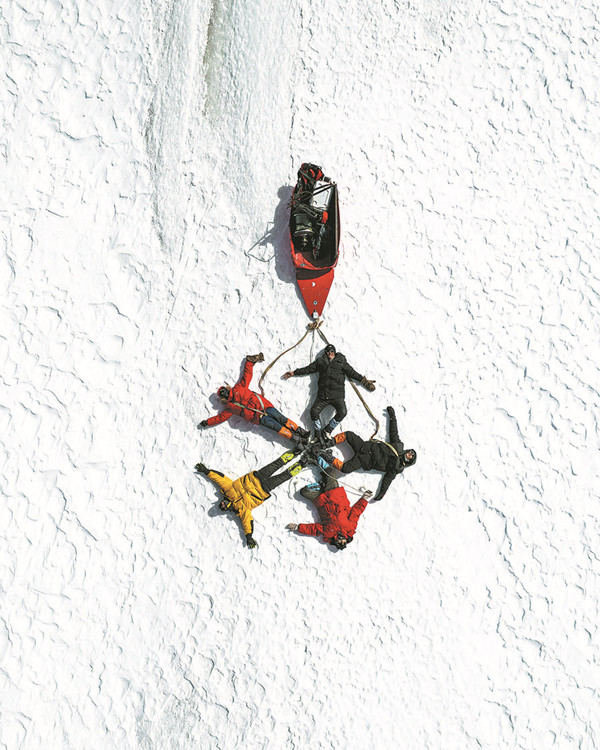
The scientific expedition team takes a well-deserved rest at Chang Tang National Nature Reserve in Tibet in 2021. [Photo provided to China Daily]
Tian explains that there are only two suitable windows each year for ice core drilling, during spring and autumn. The team set off at the end of April and returned early last month, overcoming numerous challenges.
The climate at Purog Kangri was a surprise to the team and the first hurdle they had to overcome. Heavy spring rains made the roads extremely difficult to traverse, making transportation of the drilling equipment and freezers challenging.
The team spent a full 10 days covering the 80-kilometer journey from the ice line to the glacier's summit. The planned journey from the glacier's terminus to the glacier's peak was expected to take two days, but in reality, it ended up taking the team two whole weeks.
On May 20, a month after their departure from Kunming, Yunnan province, they finally started drilling and extracting ice cores.
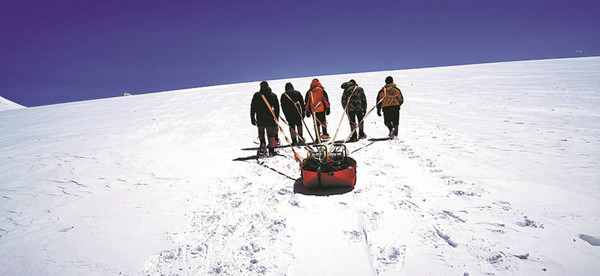
The scientific expedition negotiates the terrain on their way to drilling at the Purog Kangri Glacier in May. [Photo provided to China Daily]
The difficult and slow journey to the glacier was just the start of the problems for Tian and the team. Among the numerous other issues the expedition encountered were a technical failure of the drilling equipment and the sudden malfunction of two out of the eight ice chests brought to store the samples.
Then, while transporting the ice cores back down from the peak, the team faced drastic changes in the ice and snow at the glacier's terminus. The melting snow forced an alteration to their previously planned route. As a result, the sled carrying the ice cores overturned, resulting in damage to over a dozen samples.
The expedition originally planned to drill one or two holes to the bottom of the glacier to extract samples, but as a result of the loss, the team had to drill another hole.
Despite all of this, 55-year-old Tian never once thought of giving up.
On the 54th day of the expedition, at an elevation of 5,900 meters in the core area of the Purog Kangri Glacier, the team successfully transported the first 211 meters of samples back to the base camp.
Meanwhile, they were currently in the process of extracting the second ice core from what was the third hole.
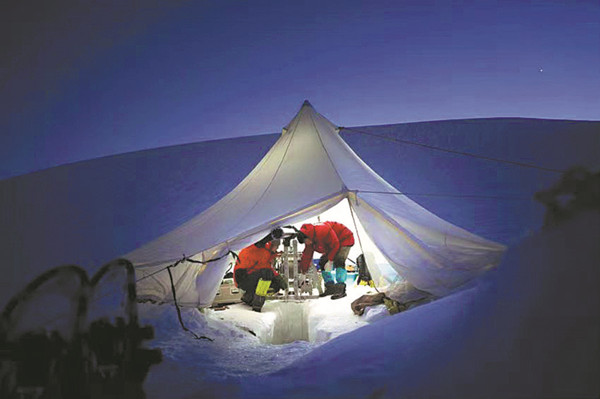
The scientific expedition team drills ice cores at Chang Tang in Tibet in November 2021. [Photo provided to China Daily]
At the time, Tian provided an update via satellite phone, noting that the team had already reached a depth of over 100 meters.
Due to the rising daytime temperatures, Tian and the team could only drill at night, and they made up for the sleep in the daytime, so for the final month of the expedition, they didn't see daylight.
Some members of the 21-person team left the expedition early, due to the harsh environment, but not Tian.
Upon his return home last month, he was 10 kilograms lighter, and his skin displayed a deep tan.
Collectively, the team had successfully managed to extract over 530 meters worth of ice core samples, which will be subdivided into multiple segments to facilitate the ongoing research conducted by Tian's team, as well as collaborative institutions both domestically and internationally. Additionally, a portion of the cores will be preserved for future research.
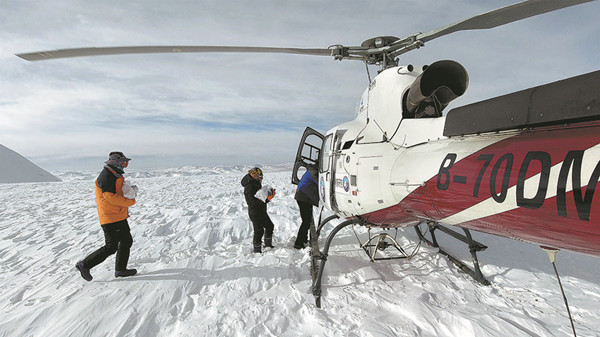
In November 2020, a drill team carries core samples onto a helicopter at the Aemye Ma-chhen Range in Qinghai province. [Photo provided to China Daily]
He says that, as the technology and means of analysis continue to improve, the ice cores that are stored will have a better use in the future.
"We used to drill ice cores together with foreign teams, but now we can do it on our own, and it gives us a great sense of accomplishment," Tian says. "This journey has accumulated a lot of experience."
In Tian's mind, the stratified glacier ice is akin to a thick diary, recording the history within the glacier's interior.
"Our country is abundant in glaciers; however, with the global climate warming up, a significant portion of them is facing a reduction in surface area, thickness and volume," Tian says, adding that this loss is leading to irreversible and irreparable destruction of essential information pertaining to the Earth's climate.
"Glaciers may not speak, but their message is found in the melting waters. Through ice core drilling, we are endeavoring to not only rescue 'the story of glaciers', but also listen to nature and heed its messages," Tian says.
An ice core is a column of ice obtained by using a mechanical drill to bore from the top to the bottom of a glacier. Each one has a diameter of 10 centimeters and a length of 80 cm.
According to Tian, ice core isotopes — or as he refers to them, "the Earth's history book" — provide information about the Earth's temperature fluctuations during past ice ages and interglacial periods, and they also record El Nino and La Nina climate events.
"For example, the data indicates a significant increase in heavy metal content in the ice cores from Himalayan glaciers since the Industrial Revolution," Tian explains.
"Ice cores, serving as invaluable records of climatic history, are of great importance. Scientists are working tirelessly to preserve these precious glacial archives before they succumb to melting," Tian says.
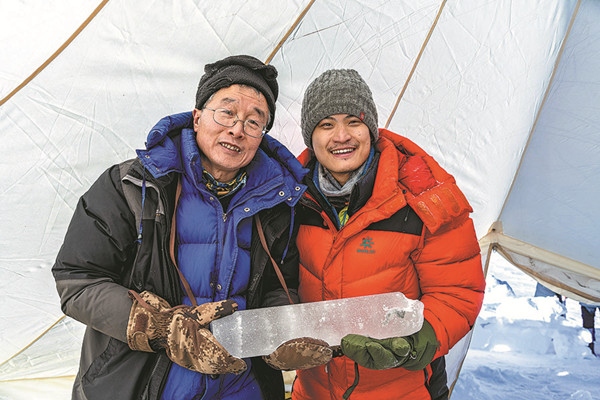
Tian Lide (left) and Wen Xu display an ice core. [Photo provided to China Daily]
Tian's trip to Purog Kangri Glacier is part of the project, Memory of Glaciers, a public welfare initiative in China that focuses on the rescue and preservation of ice cores, which aims to raise public awareness about the climate crisis and promote climate action.
"The purpose of this project is to combat climate change, salvage ice core archives and leave a complete record of ice cores for future generations," Tian says.
Memory of Glaciers is initiated by Polar Hub, a nonprofit organization in China that focuses on scientific exploration, citizen science and public education on the subject of climate change.
Wen Xu, co-founder of Polar Hub, recalls that, during an expedition on a glacier on Tangula Mountains, he encountered numerous ice lakes formed by glacial melting at an alarming rate due to climate change.
This experience led Wen to realize the urgency of addressing climate change and its impact on glaciers. As a result, he decided to take action, spreading awareness about climate change and encouraging collective efforts to confront the challenges it poses. In May 2017, Polar Hub was jointly initiated and established by Wen together with renowned domestic scientists and explorers.
According to Wen, the Memory of Glaciers project has a well-defined and long-term objective that its primary goal is to conduct rescue drilling of ice cores in mid-to-low latitudes, with a particular focus on the Qinghai-Tibet Plateau, at elevations above 6,000 meters.
"The project aims to preserve glacier archives before they vanish, thus promoting climate change research and safeguarding valuable climatic heritage for the study of the Earth's history," he says.
Over the next decade, the project aims to salvage and preserve 100 representative deep ice cores from polar regions and the Qinghai-Tibet Plateau, contributing to the establishment within the Chinese scientific community of the most comprehensive ice core repository and an ice core museum for the mid-to-low latitude glaciers worldwide.
According to Wen, in addition to the Purog Kangri Glacier, this year's Memory of Glaciers project is also in the process of conducting sustainable ice core rescue activities on Mount Muztagh Ata in the Xinjiang Uygur autonomous region. Moreover, they are planning to launch a mini-program called "watch the glaciers", aiming to involve more people in glacier protection, both online and offline.
All rights reserved. Presented by China Daily. 滇ICP备12004993号-2








